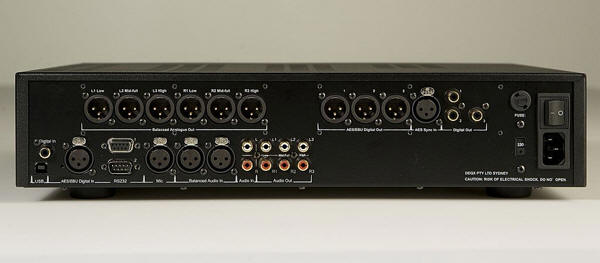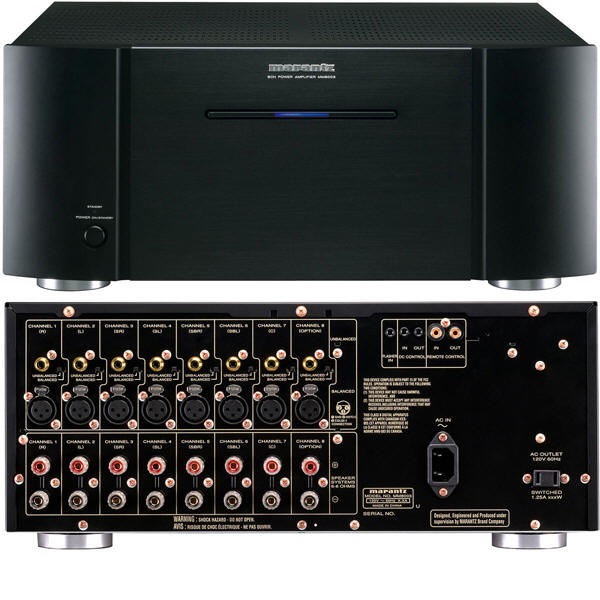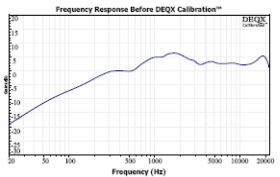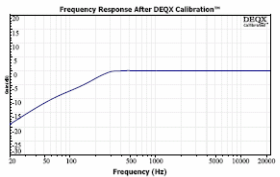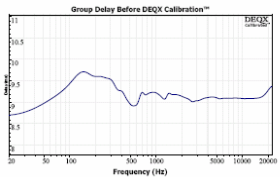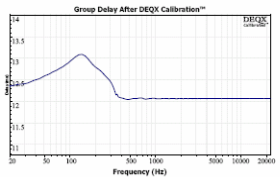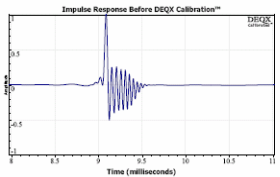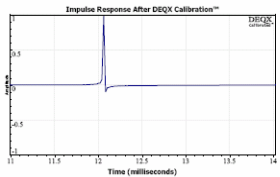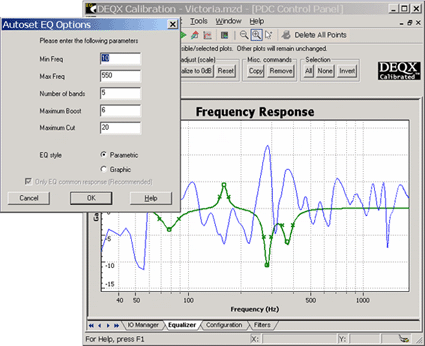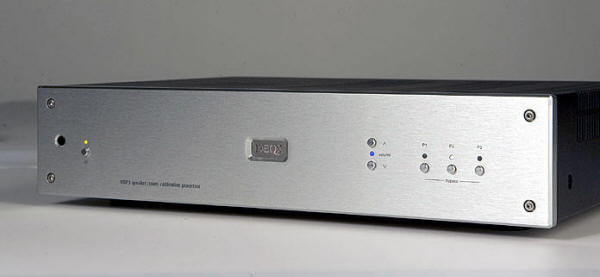|
You are reading the older HTML site
Positive Feedback
ISSUE
57
Legend Acoustics Tikandi Speaker System with
DEQX HDP-3 Preamp Processor and Marantz MM8003 Amplifier
This is by far the most difficult review I've been tasked with writing both for the complexity of the product and for the simple fact that the product is a game changer. The extensive use of digital signal processing in high-end audio, though not entirely unique, is so different from (and in my opinion superior to) the "purist" approach that meaningful comparisons are all but impossible. For some the mere thought of it borders on audio blasphemy. But read on and put your prejudices aside, for the future is upon us. The subject at hand is the Legend Acoustics Tikandi Speaker System with the DEQX HDP-3 Preamp Processor and Marantz MM8003 amplifier. (I'm just going to call it the Tikandi system for simplicity.) With the included Exakte AC cords, interconnects and speaker cables the system contains virtually everything you need so you can plug in a digital source and be ready to go . . . well, almost. At the heart of the system is the HDP-3 Preamp Processor by Australian manufacturer DEQX. The HDP-3 functions as a preamp with both digital and analog inputs, a DAC, a three way digital crossover and a Digital Signal Processor (DSP) with both speaker and room correction. It features one single-ended analog input on a pair of RCAs and one balanced analog input, (which are then digitized to either 24-bit 48kHz or 24-bit 96kHz digital). Digital inputs include a coaxial (S/PDIF) digital input and an AES/EBU digital input both capable of up to 24-bit 96kHz resolution. There is also an XLR input for a calibration microphone used to set up the system and a USB port to connect a PC for set up. Outputs include six channels of single-ended analog audio and there is an option to add six channels of balanced analog out using either active electronics or Jensen output transformers. There is also an available digital output module which provides three stereo AES/EBU outputs on XLRs along with an AES word clock sync input on XLR. The unit I received did include balanced audio out but not the digital out option. The volume control is completely analog and the channels are matched to 0.1dB. Though as you shall soon see, this and almost every aspect of the HDP-3 can be adjusted in any number of ways.
The Marantz MM8003 is an eight channel amplifier producing 140 watts per channel into 8 ohms. The rear panel features eight single-ended and eight balanced analog inputs along with eight pairs of five way binding posts. At a little over 17 inches wide, cramming 8 pairs of speaker cables onto the binding posts was a bit of a task. The HDP-3 can be set up in a number of different configurations; the simplest being two of its channels driving a pair of full range stereo speakers through their internal crossovers with the unit providing speaker and room correction. The most complex set up employs all six channels out correcting the frequency and phase response of each driver of a three way stereo speaker system individually while acting as a digital crossover and providing room correction. This is how it works in the Tikandi system. The technical aspects of the HDP-3 are vast due to its highly complex functionality. For a more thorough description I urge you to visit the DEQX web site, www.deqx.com. Setting up the HDP-3 is not like setting up a typical audio component. It takes grasping some basic principles of speaker design, speaker measurement, and room acoustics. The level of control it provides over a speaker's behavior is infinitely greater than one would find in an analog system making it as easy to completely screw up the sound as it is to achieve total bliss. Fortunately the typical buyer will have the system set up by a knowledgeable dealer, and in my case the Tikandi system was set up by Larry Owens of KRC; importer and service agent for Legend Acoustics and DEQX in the Americas. Even so, it's worth becoming intimately familiar with how the HDP-3 works as the kind of fine tuning that can only take place after weeks of listening can pay off in spades with this system; if you know what you are doing. The learning curve is a bit steep but the manual is well written and the support from DEQX is exceptional. You may still be thinking, digital crossover, room correction, digitizing analog - audio blasphemy! There is a fair amount of audiophile approved dogma to support this view. But in the words of the poet, the times, they are a changing. So I'm going to digress for a moment to discuss what is perhaps still the biggest problem in high-end sound reproduction… if only to create a context to understand how important a product this is. Room acoustics have been an issue, or more accurately, a problem since the dawn of audiophilia. In fact, I don't think it's unfair to say that room acoustics create the grossest errors of any part of the audio chain. Yet this issue is completely ignored by a large majority of audiophiles… while attempts to address it are often feeble at best. Yes, wall treatments, bass traps, and many other accessories can and do improve things, sometimes quite a bit. Simple treatments are even relatively affordable. But for the most part they fall far short of what's possible and certainly don't thoroughly deal with the room such that it is no longer a huge problem. Even in "good" sounding rooms, it's still a problem! Unless you hire a qualified acoustician you are unlikely to achieve anything close to the ideal. It's a complex subject and the results can be unpredictable. So short of that approach, even in a greatly improved room, you will still be missing much of what your system has to offer. And the truth is that many audiophiles don't bother with even rudimentary acoustic treatments. It's just not sexy. Instead most of us throw better components, more expensive cables, anti-vibration racks and all manner of voodoo at our systems in the hope of better sound. Done properly this does help, but the room is still literally killing the sound. I imagine many readers will disagree because your set up sounds pretty good. The problem is you haven't heard your gear in a properly designed room so I will simply assert you don't know what you're missing. Tone controls? How many high-end systems have you seen with tone controls; and I don't feel I have to explain the reasons why not. Parametric equalizers? Even worse, though there are some notable exceptions there; the Rives Audio PARQ being one. But not many have even felt the need to consider it, let alone try it. Years ago the Cello Palette Preamplifier offered audiophiles high-end equalization. Though I never had the chance to experience it, from what I understand it was a good idea and it worked. But it never changed the world. That is it didn't alter the predominant audiophile view that equalization is unequivocally bad. Like the Newton, it was ahead of its time. And it was expensive at $6500 in 1992. After the room, the next biggest source of inaccuracy in most systems is the speakers. Most speakers have serious non-linearities. The majority have pretty flat frequency response but the phase response is all over the map. In other words some frequencies arrive early, some arrive late and those timing errors suck the life out of the music. They soften the sound stage focus and throw the timing of the music off in subtle but clearly discernable ways. (Most would probably only notice the presence of phase errors once they are eliminated). Very few speakers systems really deal with these issues effectively and the ones that do are, for the most part, very expensive. Enter digital signal processing. In a nutshell, a DSP unit will fix what's wrong with your speakers and most of what's wrong with your room, all at the push of a button. I have been a drum major for DSP since first hearing the Trinnov Audio Optimizer turn a pair of mediocre speakers in a crappy hotel room into something approaching audio nirvana (after several hours of tweaking.) It may sound too good to be true, but you would have said the same thing about the iPhone not that many years ago. A lot has happened between the introduction of the original Quad ESLs and the digital revolution. Chips continue to get more powerful and less expensive and with the explosion of high resolution, networked digital audio sources, feeding that signal into something like the DEQX HDP-3 just makes more and more sense. And if you love vinyl or tape (or FM!), the HDP-3's analog inputs will convert your analog source to digital and perform its magic on whatever you feed it. I'm getting a little ahead of myself here but DSP works so well it has ruined me for anything else. I've hardly turned on my system, other than to watch movies, since the HDP-3 exited my listening room quite some time ago. During my experience with it, Joe Cohen of the Lotus Group called me before CES for some advice on whether to use an analog or digital crossover with built in DSP in his Granada loudspeakers. I did my best to persuade him to go digital and he did. At that show, those speakers were considered best of the show by some of the most respected journalists in the industry. Walking around CES that year, fresh off my experience with the Tikandi system, with only a few exceptions, every room at that show sounded dreadfully wrong. My own system, without the HDP-3, sounds dreadfully wrong. You need this; you just don't know it yet. The HDP-3 is set up by connecting the USB port on its rear panel to a PC running DEQX's proprietary Cal software. First the unit plays a time-gated tone sweep through your speakers while a calibrated microphone listens to each driver of your speaker system individually, sending the result from the HDP-3 to the PC. The software does all of the number crunching and calculates digital filters that "fix" each driver. That is it flattens the frequency response and corrects phase and timing errors. You can limit how much correction is applied and experience has shown that while you can make each driver behave "perfectly" it can become too much of a good thing. The software then wraps the filter in a digital package and sends it back to the unit where it processes the signal. Once you are done setting up the HDP-3 the PC can be disconnected.
The HDP-3 also works as a digital crossover. If you have a typical two or three way speaker system you won't use this aspect of the HDP-3 unless you disconnect or bypass your speakers' internal crossovers. In the Tikandi system, the speakers of course have no crossover; rather they depend on the HDP-3 to provide that function. The HDP-3 can also advance or delay the timing of each driver individually so that the summed output is time aligned. Aside from the flexibility of a digital crossover another benefit is that it's exact. Tweaking the settings I found that moving the crossover point of just one driver by 5Hz could make the difference between just okay sound and great sound. Now think about this, parts have a tolerance. If you determine the crossover frequency of any network by calculating the resistance, capacitance, and inductance of its components, and then factor in the tolerance of those parts, plus the tolerance of the drivers, you will see that it's quite likely that you will end up an error quite a bit more than 5Hz from the design specification. One of the (many) reasons for the exceptional sound quality of the YG Acoustics speakers is that each crossover is custom modeled to the exact drivers used in any given pair of speakers. With the HDP-3 you can achieve that level of precision for a whole lot less money. The last major frontier that the HDP-3 tackles is room correction. Using the same swept tone and calibrated microphone the unit measures the in-room response of the corrected speakers at the listening position and displays the results in the software. The built in and highly flexible digital parametric equalizer allows you to finely tune the in-room response of the system. Once again, while it's possible to make the in-room response nearly "perfect" that never sounded the best. Tackling the biggest errors with the least amount of correction possible worked best. Even subtle changes could make the sound go from good to mind-blowing. Seriously. The HDP-3 can store four full sets of user settings containing speaker configurations including speaker correction, crossover, and room correction settings. One of the four positions is typically set to bypass meaning it contains only the crossover settings (if you are using the active crossover, otherwise it's straight bypass) but it can store any information the others can. You can create one setup, copy it to the next user position and tweak it, copy that to the next user position and tweak it some more and then using the unit's remote, switch between setups to determine if you are making things better or worse. All of those settings are stored in a project file on the PC which can be copied, moved, or emailed to DEQX for review. You can have as many project files as you want, each with multiple sets of user settings, which can then be loaded into the HDP-3 (up to four at a time) giving you literally an infinite number of set ups. But that way lies madness. Another benefit of digital speaker correction is the flexibility it affords in speaker placement. I'm lucky enough to have a dedicated room and an understanding wife, but I still find that where speakers sound best in my room isn't always where I would like them to be. Even with digital speaker correction, you will achieve better results by starting with the best speaker placement possible. But when that's not possible, DSP will resolve placement caused issues that simply cannot be resolved any other way. Setting up this system is a rather daunting and time consuming task. The installation manual is 193 pages long and the user manual is another 39. But it's well written and that makes following the somewhat complex process simple enough. Knowing how to interpret the data provided and optimize the settings to the best effect is another matter entirely. The myriad settings and options offer a virtually infinite number of combinations that can produce results ranging from spectacular to horrid. Knowledgeable assistance is critical and fortunately, dealer set up is included in the price. I found Larry Owens to be exceptionally knowledgeable not only about the Tikandi system but about audio in general. He performed the initial set up and his guidance proved invaluable in understanding the system enough to be able to make incremental improvements on my own. When Larry first arrived with the Tikandi system I had one of the finest set ups I've ever heard doing duty in my listening room; YG Acoustics Anat Reference II Studio speakers, a pair of Spectron Musician III Mk. 2 amplifiers, an E.A.R. 868 preamp and a variety of digital sources that were filling in while my Vacuum State modified DVP-S9000ES was receiving an Uber Clock upgrade. This set up had been providing night after night of audio nirvana, so while I was curious to see what the Tikandi system could do, I wasn't entirely ready to move on. I asked Larry if we could first set up just the HDP-3 in my existing system to see what effect it might have. He obliged and I watched as Larry ran through the set up procedure, configuring the system in bi-amped mode. Two channels from the DEQX powered the YG Acoustics satellites through the Spectron amps while two more channels drove the YGA stereo subs' built-in amplifiers. The subs were run with their internal crossovers turned off and the DEQX set to low pass at 40Hz. The satellites were run full range. Pseudo anechoic measurements of the satellites showed them to be exceptionally flat in the frequency domain with very little group delay. The correction filters built by the HDP-3 were appropriately subtle due to the speakers' excellent inherent performance. We then measured the in-room response of the subs and had the software build filters to correct the lumpy bass afforded by my room. A bit of parametric equalization smoothed out the in-room response of the entire system and we were ready to go. Prior to the DEQX, I really couldn't have imagined this set up sounding any better in my room than it already did. And while the difference wasn't night and day with the DEQX, it was quite substantial and more than worthwhile. Most noticeable was the improvement in soundstage focus. Images, without correction, were exceptionally holographic and weighty on the YGAs; diffuse is not a word I would have ever used to describe them. But after listening to the system with the DEQX in place I found the uncorrected images a bit vague by comparison. The soundstage opened up with a greater sense of separation and air around each instrument, a greater sense of real musicians playing in real space. I can't emphasize enough that we were going from something that was already among the best I had ever heard to something quite superb. Prior to installing the DEQX there didn't seem to be any kind of noise floor to the system, but with the DEQX it seemed subtle layers of artifice fell away. The sound became even more relaxed and natural with a greater sense of musical flow. Powered by the Spectrons the YGAs produced some of the most effortless and palpable reproduced sound I've ever heard. The HDP-3 enhanced all of the YGAs' exceptional qualities without detracting a thing. This really was having it all. In the context of such an expensive system, the cost of the DEQX is almost incidental and I would consider the unit an absolute necessity to get the best out of it. But this nirvana was only to last a day as tomorrow would come and with it Larry to set up the Tikandi system, the real subject of this review. Using the included Exakte interconnects, digital, and speaker cables, a digital source was connected to the HDP-3 and four of its six channels were connected to four channels of the Marantz MM8003 8-channel amplifier. The two remaining channels of the HDP-3 were each split in two using a Y-Connector and directed to the four remaining channels of the amplifier. The Tikandi speakers were then wired so that each driver had its own amplification channel.
After everything was wired, the drivers were measured individually using the calibrated microphone and six correction filters were built, one each for the tweeter and midrange drivers with each pair of sub drivers sharing a filter. The speakers' corrected frequency response was approximately +/- 0.5dB with virtually no group delay. Again, tighter tolerances could be achieved but that seemed to become too much of a good thing.
Images courtesy of DEQX A digital crossover was then built with the software providing a choice of crossover type, slope, and high and low pass points. After taking in-room measurements at the listening position a bit of judicious parametric EQ was applied to smooth out the bumps in the bass and we were off to the races. While describing the sound of the system isn't terribly difficult, finding meaningful comparisons is. Changing just speakers for example and comparing them to a reference or several references is one thing, but the HDP-3 has such an impact on whatever is downstream that I think it's worth examining its performance both in the context of the Tikandi system and as a standalone product. In my room (and in virtually any room, that's the magic!) the Tikandi system produced extremely well defined, focused, and lifelike images with tight, articulate bass, and a very natural tonal presentation. It was rich, in a good way, though it didn't quite have the transparency of the sans DSP YGA/Spectron combo. It couldn't muster the attack speed, sharpness, and punch of the YGA/Spectron combination, nor did it resolve ambience detail in the same way.
Images courtesy of DEQX Aside from the fact that the YGAs are $70,000 (and worth it in my opinion) at least some of the difference is due, I feel to the differences in amplification. The Spectrons are a very different animal than the Marantz and most other amps for that matter. They are nearly 2000 watts per channel. They are faster and more articulate than anything I've heard. Their ability to resolve the tonal colors and nuances glossed over by other amplifiers was evident with every loudspeaker with which I heard them. There is simply no amount of upstream DSP that can make an amp faster or more powerful than it is. If I had swapped out the Marantz for four, or even three Stereo Spectrons, I believe the gap would have been a lot closer if there were one at all. But the differences weren't that great and were wildly inconsistent with the price difference. The fact that I can even compare these systems should tell you something. The Tikandi system sounds like one costing over $100K for less than the cost of a Nissan Altima. A base model even. Comparisons aside, the Tikandi system was extremely transparent and very dynamic sounding. Even if it wasn't quite as explosive and dynamically effortless as the YGA/Spectron system (among the world's best in this regard) the Tikandi system was close enough that I didn't miss it. I really didn't think that would be possible. The Tikandi system actually exceeded the YGA/Spectron combo's ability to bring the original recorded space into my room, replacing the room's ambience with that of the recording's. There was a vividness and palpability to the presentation that was unlike anything you will likely hear without the benefit of DSP. The localization of not just instrumental images but also ambience cues brought not just the music to life but brought the entire event to life. A "you are there" quality would transport you to the recorded space in a remarkably seductive way. "April 1st" from the Peter Epstein Quartet's Staring at the Sun (CD, M.A Recordings M041A) begins innocently enough. A simple and sweet saxophone melody is soon joined by drums, accordion, and acoustic bass. Then after just a hint of the avant garde cacophony to follow, the piece settles back into a safe, seductive groove. It then launches into an instrumental free for all that barely toes this side of the line between music and chaos. It's pure genius, inventive, addictive, it dances on the edge of comprehension. And the recording quality is unparalleled. I could say that through the Tikandi system the recording took on a startling, well defined quality but most likely you would be thinking of this phenomenon in terms of what you have experienced from non-DSP systems. The phrase "instruments well placed within the sound stage" doesn't even begin to describe what I heard. Each instrument became distinct in a whole new way. One of the advantages of DSP, and I think this has mostly to do with correcting the phase response, is things just come into focus in a way that only happens in the most expensive, most painstakingly set up systems (which includes dealing with the room acoustics). The bass was exceptionally well defined with an almost luminescent quality. It was at the same time both thunderous and well controlled creating some of the best bass I've ever heard in my room. In fact the bass drum on this recording didn't even sound like the same instrument I had been hearing… so many nuances were revealed that had been previously masked. Subtle glances of the mallet against the drumhead and the well resolved resonance of the instrument added incredible dimension and realism to the sound. The performance was captured by a single pair of stereo microphones in the highly reverberant Saint Peters Episcopal Church in NYC. Lesser systems will certainly have a tough time sorting out the primary sound from the abundant ambience. At several points on the track the musicians play with such freedom of expression and abandon that it borders on musical anarchy. The Tikandi system easily made sense of what might otherwise become a jumble of noise and most importantly maintained the integrity of the musical intent of Epstein and his crew. The Tikandi system really allows you to hear music the way the artist intended. Marcus Miller's "Cousin John", M2, (CD, Telarc CD-83534) is a richly layered, extremely bass heavy track. Many systems are unable to sort out the individual instrumental lines of this piece turning the complex interplay of the players into musical mumbo jumbo. Even with the best equipment, the room, especially in the mid to lower bass, can easily distort the frequency response and smear the sound resulting in a sort of musical mumbling. Through the Tikandi system the electric bass was, not surprisingly, extremely visceral and articulate. With its ability to tame my room's lumpy bass, the Tikandi system provided a window into this highly complex mix that few systems could rival at any price. So, do I love this system? Yes, yes, and again yes. My own system is no slouch, but compared to the DSP driven Tikandi system it sounds positively diffuse by comparison. When I state above that it ruined me, I'm not kidding. I've barely listened to my system in the many months since the Tikandi system left my room. At the next CES I attended, with a few exceptions, I could barely sit through most of the demos because I had grown so accustomed to the natural and lifelike sound of the Tikandi system. Everything sounded broken to me, an opinion shared by my friend and manufacturer Alan Kafton of Audio Excellence who had spent much time at my home marveling at the Tikandi system. Still, I do have a few complaints about the HDP-3. First of all it has only one single-ended analog in. That's probably okay for a lot of people these days, but if it's going to function as a preamp it should have more. The balanced input is also a bit of an issue. In the preamps with which I have tried it, my Vacuum State Logic modified Level 7 Sony DVP-S9000ES sounds noticeably better through its balanced output than through its single-ended output. Through the HDP-3 the balanced analog input didn't sound quite as good as the single-ended. If DEQX is going to offer a balanced option I feel they should take full advantage of what the source component has to offer. Otherwise it's just a waste. On the whole I found the analog inputs a bit drier and slightly strident compared to the digital input. In both single-ended and balanced the analog in was a bit grainy, and I feel the analog to digital conversion wasn't as transparent as it could be. If you are using an audio server or transport to drive the DEQX via its digital inputs it's not a problem but your high quality analog sources are going to suffer a bit in the conversion. I would like to see, at least as an available option, ultra high quality analog to digital conversion. That's not so much a condemnation of the ADC as a testament to the quality of the unit as a whole. It does such an amazing job of getting you closer to the absolute sound that DEQX owes it to its customers to offer the highest quality possible, within reason, at every stage of the chain. On the other hand, if I were a vinyl junkie or a reel to reel guy with a top notch analog rig and I was looking for the finest performance possible, I would skip HDP-3's analog inputs altogether. Instead I would buy the best outboard analog to digital converter I could afford and go digital in. I imagine one could be had with multiple analog inputs as well, solving that issue in the bargain. It adds to the cost, but in the context of a top flight system, I believe it makes sense. Curious about how each element of the Tikandi system was contributing to the sound I was getting, I stacked each element against some the gear I had on hand. I did my best to compare as many permutations of the set up as possible without going crazy. In no particular order here is what I found. DEQX/RM 200/A.C.T vs. Tikandi Following the instructions in the extensive HDP-3 user manual, and with a bit of assistance from Larry Owens, I set up the DEQX unit driving my own Music Reference RM200 amplifier and my Wilson Benesch A.C.T. speakers. Though the manual is quite long and involved, it deals with the rather complex set up process quite clearly and systematically. Larry's help was invaluable when it came to the subtleties of how to tweak the settings to get the best results, but the manual covered the fundamentals of the set up exceptionally well. In my initial impressions, the Tikandi system had greater transparency, was more effortless, and showed greater soundstage specificity. It was a bit less grainy sounding overall, more open and played with greater authority. This comes as no surprise comparing a three-way, eight amplifier active crossover system to something that simply wasn't made to do that. You can tell that the Tikandi speakers and the DEQX HDP-3 were made for each other. An advantage of having speakers with no passive crossover is there are no crossover parts to introduce loss, distortion, and timing issues. But as I tweaked the settings in my system the gap began to close. About a week in to this set up I spent one late night, with the help of an XTZ 1/3 octave room analyzer, tuning the room response with the HDP-3's built in parametric EQ. I largely left the dips alone and tempered the bumps, backing off the EQ a little at a time. I found less is more when it comes to room EQ and there was a point when suddenly it all just clicked and magic happened. I was shocked at how a profound, yet seemingly small adjustment to the in-room response altered the sound. My system was now sounding a lot closer to the Tikandi set up. The increase in transparency was astounding and the soundstage took on an entirely new level of three dimensionality. Like the Tikandi, the system started to approach the kind of precision and revealing nature one can obtain from the YGA speakers or a pair of Wilson Audio MAXX IIIs. The Listening Environment Diagnostic Recording (LEDR) an imaging test from Chesky Records' Jazz Sampler & Audiophile CD (CD, JD37) was never so precise. My set up still couldn't match the Tikandi's level of authority and its bass remained unequaled, but my system never sounded better, by a wide margin. Which brings me back to my original point. You need DSP. You will never be able to obtain the kind of results that come from tuning your system with such a fine instrument any other way. DEQX/RM 200/A.C.T vs. Pre30/RM 200/A.C.T. Comparing the DEQX unit in my system to my usual preamp, a Primare Pre30 there was no contest. With the HDP-3 (digital or analog in) driving my RM200 and A.C.T. speakers focus, imaging, separation, tonality; all were vastly better than with the Pre30. The Pre30 however was more transparent. The acid test was comparing the Pre30 to the HDP-3 on straight bypass with no DSP engaged. In this mode the DEQX sounded noticeably more ragged, grainy, and diffused. On the whole I much preferred the sound of the system with the DEQX with DSP. But I would really like to see it get a fully balanced analog input stage with improved analog-to-digital conversion. Those digital conversions just have to be totally transparent. DEQX/RM 200/A.C.T vs. E.A.R. 868/RM 200/A.C.T. Swapping out the DEQX processor for the E.A.R. 868 preamp the results were similar to when I swapped it for the Pre30. While the Tikandi system was clearly more defined and tighter sounding, the excellent E.A.R. 868 was even more transparent though also diffuse. Ideally the HDP-3 on straight bypass, with no DSP correction, whether through its analog or digital inputs, would sound as transparent and musical as the E.A.R 868. That being said I will take the HDP-3 with its DSP any day. DEQX/RM 200/A.C.T – Calibrated DSP vs. Bypass Comparing the DEQX driving my A.C.T. speakers on straight bypass (no speaker correction, no room EQ, speaker internal crossover) to the digitally corrected settings was also no contest. On bypass the sound was tubby, diffused, nasal and soft. The ambience cues were indistinct and seemed to come from all over providing a sense of space, but not a very specific space. With the DSP engaged, the ambience cues took on a specificity that gave the room not just a sense of space… it resolved the shape and depth of the space in a seductive and uncanny way. The DSP corrections added a greater sense of life, image specificity, depth perspective, and most importantly, far greater emotional involvement. It really was mind-blowing. DEQX/Marantz/A.C.T vs. DEQX/RM 200/A.C.T. Lastly I compared the DEQX driving my A.C.T. speakers via the Music Reference RM200 to two channels of the Marantz amp. The Marantz, though a touch more resolving, was drier sounding and not quite as dynamic. As part of a relatively cost effective system I can understand using the Marantz amp, and in the context of the full blown Tikandi set up it provided me with countless hours of musical enjoyment. Still, I don't think having eight channels of amplification on a single chassis driving a system that requires lots of headroom is the best choice. (I once heard the HDP-3 driving a pair of Acoustic Zen Maestros with the crossovers removed to take advantage of the active crossover. The amps were three Halcro monoblocks per channel and the results were astounding.)
If I had to choose between the YGA/Spectron system without DSP at roughly five times the cost and the Tikandi system, (and money wasn't a factor) it would be a tough choice. I think I would give a slight nod to the pricier system, but on another day I might go the other way. Either way I would be extremely satisfied. (The ideal would be to have the YGA/Spectron system with DSP.) I have no doubt that DSP, properly implemented, will make a worthwhile, sometimes mind-blowing improvement to any system and the Tikandi set up plays with the big boys, the really big boys, at a fraction of the cost. If you are looking for a full-blown system in this price range you won't match the Tikandi system's value. You should just go buy it… you won't believe your ears. Better yet, do some shopping around for systems at that price point and then go listen to the Tikandi. You will be shocked. If you already have a system and are not looking to replace the amp and speakers then the DEQX HDP-3 is going to make your system sound better than it possibly can by any other reasonable means. It will make your speakers behave like a far more expensive pair even if you already own a very expensive pair. If you are considering any kind of upgrade, this is the place to start. It's the most cost effective improvement I can think of and deals with the worst source of distortion in your system; your room. Equalization has been a bad word for a long time among audiophiles. It's time to get over it and embrace a brave new world. Manufacturer's comments - Dr Rod Crawford, Legend Acoustics Many thanks to Adam for his insightful and excellent review of our Tikandi loudspeaker system. As Adam points out, much of the quality of the sound of the Tikandi system derives from the DEQX processor with its signal management and correction processing in the digital domain where they can be done very accurately. However, I would like to point out that Tikandi's sound quality is in no small part also due to the speakers themselves, particularly the integrated design of the cabinets and choice of drivers, an art that I learnt as chief loudspeaker designer at Linn Products in Glasgow in the late 1980s. We agree with Adam's comments on the intrinsic limitations of the Marantz MM8003 amplifier. This 8-channel amplifier was chosen to show that stratospheric sound quality can be obtained at very down-to-earth prices—without a room full of hi-fi equipment. We were most pleased to hear from Adam about our success with that! For those who like to keep the set-up simple, the Parasound HALO multi-channel amps have proven to deliver excellent sound quality—still without breaking the bank. Like all high-end speakers, Tikandi will respond to your choice of amplification; except now you'll be able to enjoy all of its special character unobstructed as never before. We would like to extend our sincere appreciation to Adam for his very comprehensive and in-depth review of Tikandi. As he tactfully pointed out, these are not your father's stereo speakers and there's much to be said about that... which Adam has done brilliantly. Thank you.
Legend Acoustics
Tikandi loudspeaker system (includes 8 hours DEQXpert™
services)
Marantz MM8003 8ch
amplifier
Exakte Tikandi Cable
System (RCA)
|

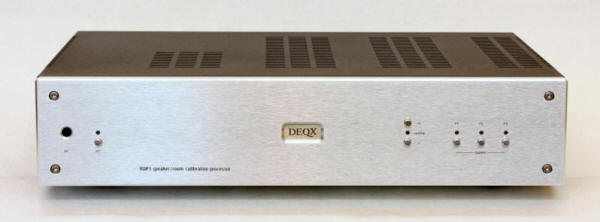
 The Legend Acoustics Tikandi speaker system, also
from Australia, is a three way system with no crossover, designed by Dr. Rod
Crawford, specifically to work with the DEQX HDP-3 unit. Shaped like truncated
pyramids, the speakers look familiar enough with a pair of small satellites
mated to stereo subwoofers. Each satellite contains a tweeter and midrange
driver while each sub cabinet contains a pair of diametrically opposed, side
firing ten inch drivers capable of nearly an inch of excursion and 20Hz bass.
The tweeter and midrange units are each wired directly to their own binding
posts while each sub terminates in a four conductor Speakon connector that
allows each woofer to be driven by its own amplifier. The speakers can also be
supplied with built-in amplifiers to drive the bass modules. Mine were not.
The Legend Acoustics Tikandi speaker system, also
from Australia, is a three way system with no crossover, designed by Dr. Rod
Crawford, specifically to work with the DEQX HDP-3 unit. Shaped like truncated
pyramids, the speakers look familiar enough with a pair of small satellites
mated to stereo subwoofers. Each satellite contains a tweeter and midrange
driver while each sub cabinet contains a pair of diametrically opposed, side
firing ten inch drivers capable of nearly an inch of excursion and 20Hz bass.
The tweeter and midrange units are each wired directly to their own binding
posts while each sub terminates in a four conductor Speakon connector that
allows each woofer to be driven by its own amplifier. The speakers can also be
supplied with built-in amplifiers to drive the bass modules. Mine were not.
